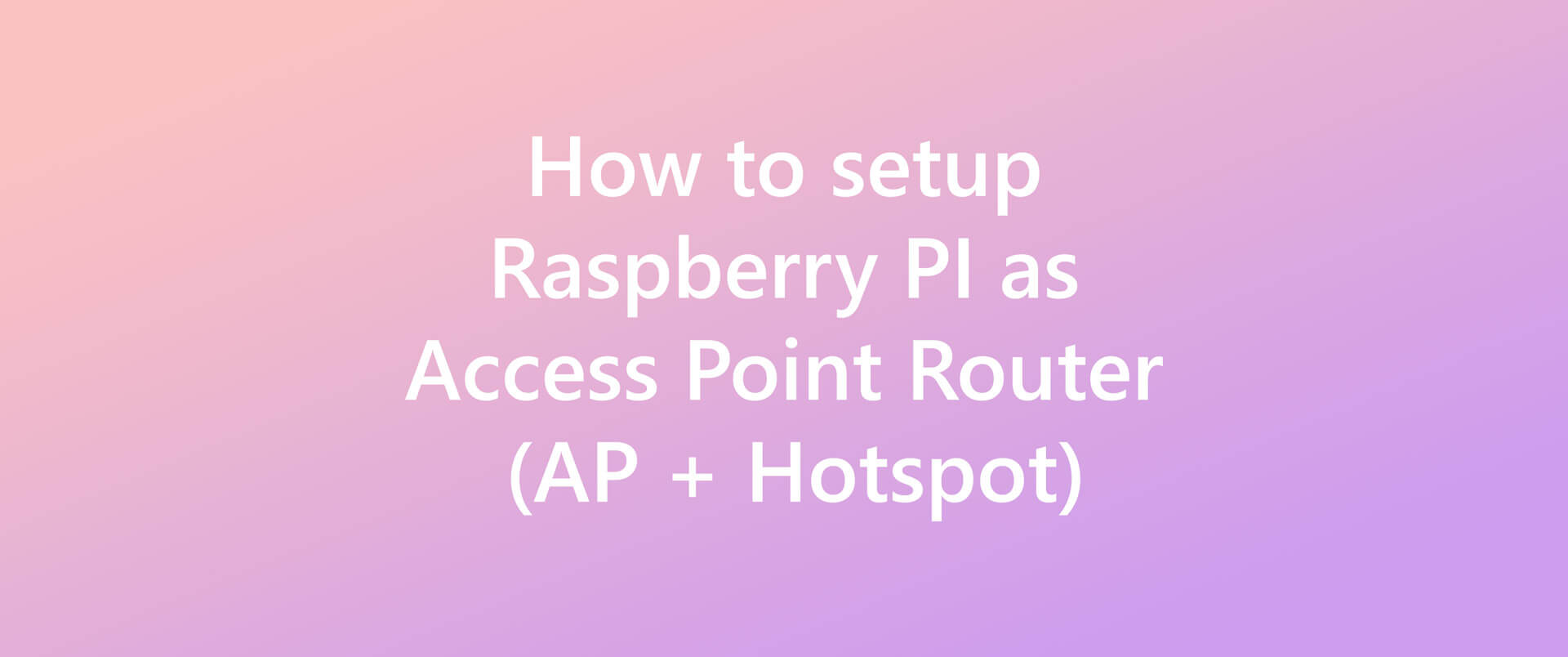Raspberry Pi (Rpi) 3 has built-in wireless adapter and it can be used as a router. In this guide, Rpi will be connected to your Local Network via Ethernet and it will distribute new IP addresses (DHCP in Raspberry Pi) via WiFi adapter as a HotSpot to any other device that will use Raspberry Pi as router.
This guide expects you to be able to install Raspian OS. When this guide is created, Raspian OS (Linux 9 Stretch) was the up-to-date operating system.
Attention: I suggest you to use keyboard and mouse to follow this guide. You will also need internet connection via ethernet to be able to install some services.
1.Installing Services
We need two major services for this specific system. “dnsmasq” and “hostapd”. Dnsmasq is required to distribute IP addresses and Hostapd is the service that is used to make Rpi WiFi Adapter to act as hotspot.
Enter the following command in the terminal to install “dnsmasq” and “hostapd”
sudo apt-get -y install hostapd dnsmasq
This command will install both “hostapd” and “dnsmasq” at the same time.
2.Set Static IP Addresses to Distribute
a.Setting “dhcpcd.conf”
“dnsmasq” service has the features to set DHCP and DNS protocols. Hence, we will set the Rpi to ignore default DHCP settings. Enter the following command to terminal to open “dhcpcd.conf”.
sudo nano /etc/dhcpcd.conf
Add the following line to the bottom of the file:
denyinterfaces wlan0
When it is done, press “Ctrl + X” to save; press “y” and then “Enter” to confirm and complete the saving.
b.Setting “interfaces”
Interfaces will be set to tell how the interafaces will get the corresponding IP Addresses. Enter the following line to the terminal to open the interface file:
sudo nano /etc/network/interfaces
Enter the following settings to the bottom of the file:
#loopback interface settings auto lo iface lo inet loopback #eth0 settings option 1 #Uncomment next two lines to get available IP from local network #auto eth0 #iface eth0 inet dhcp #eth0 settings option 2 #Uncomment next five lines to get static IP from local network auto eth0 iface eth0 inet static address 192.168.0.69 netmask 255.255.255.0 gateway 192.168.0.254 #Hotspot interface settings allow-hotplug wlan0 iface wlan0 inet static address 192.168.X.1 netmask 255.255.255.0 network 192.168.X.0 broadcast 192.168.X.255
The “X” at the IP addresses is variable (This guide chooses “X” as “42”). Just make sure the addresses here are not same with the local modem’s. Even though, technically, using same IP does not cause any trouble but it would only be confusing for the user (User might not differentiate where a new device gets its IP address.). If Rpi needs static IP uncomment “eth0 settings option 2”, else, “eth0 settings option 1” should be uncommented. If you set an IP address that is already in use by another device, you won’t be able to get an eth0 connection.
When it is done, save and exit the file.
2. Setting HOSTAPD Configuration
“hostapd” service is used to broadcast specific SSID around so, other devices can connect to the Rpi with a password. To configure the hotspot settings, “hostapd.conf” file will be edited.
sudo nano /etc/hostapd/hostapd.conf
Enter the following settings to the file:
interface=wlan0 hw_mode=g channel=7 wmm_enabled=1 macaddr_acl=0 auth_algs=1 ignore_broadcast_ssid=0 wpa=2 wpa_key_mgmt=WPA-PSK wpa_pairwise=TKIP rsn_pairwise=CCMP ssid=Rpi-Hotspot wpa_passphrase=password
When it is done, save and exit the file.
We need to tell “hostapd” service where the “hostapd.conf” file is located. So, enter the following command to the terminal:
sudo nano /etc/default/hostapd
Fine the line (You can use “Ctrl + W” to search for it.):
#DAEMON_CONF=””
And, edit the line as this:
DAEMON_CONF="/etc/hostapd/hostapd.conf"
When it is done, save and exit the file.
4. Setting DNSMASQ
“dnsmasq” service has the ability to assign specific IP address range to the clients. First, we will get a backup of “dnsmasq.conf” file because it includes very useful information that might be useful in the future.
Enter the following command to the terminal to save a copy of the original “dnsmasq.conf” file:
sudo mv /etc/dnsmasq.conf /etc/dnsmasq.conf.bak
After the original file is secured, enter the following command to the terminal to edit the freshly created “dnsmasq.conf” file:
sudo nano /etc/dnsmasq.conf
Enter the following lines to the blank “dnsmasq.conf” file:
interface=wlan0 listen-address=192.168.X.1 bind-interfaces server=8.8.8.8 domain-needed bogus-priv dhcp-range=192.168.X.2,192.168.X.100,24h
“X” in the addresses should be same with the what you have set at the “interfaces” settings (In this guide, it is choosen as “42”). Since “192.168.X.1” is reserved for the Rpi, we set the DHCP range from “192.16.X.2” to “192.168.X.100” and they are reserved for 24 hours. Range can be increased or decreased. Other IP addresses (From “192.168.X.101” to “192.168.X.254”) can be used as static IP by the other devices.)
When it is done, save and exit the file.
With the latest versions of Raspbian, “hostapd” service is installed as “masked” or “inactive. To unmask it, enter the following line to the terminal:
sudo systemctl unmask hostapd
At this point, Rpi is ready to be used as an Local Access Point. It is “Local” because we didn’t tell Rpi how to direct the network.
You can connect to the “Rpi-Hotspot” network and confirm that the device gets an IP in the range that we have defined in the “dnsmasq.conf”.
Attention: You need to reboot the system for the Access Point to work but, before the reboot, we can set the “Packet Forwarding” so we can connect to the internet with a client device.
5. Setting the Internet Connection (NAT Settings)
Enter the following command in the terminal:
sudo nano /etc/sysctl.conf
Search (Ctrl + W) for the following line:
#net.ipv4.ip_forward=1
And, uncomment the line (Remove “#”).
When it is done, save and exit the file.
Now, we configure the Network Address Translation (NAT) between Ethernet and WiFi so, packets can be forwarded from Ethernet to WiFi or vice versa.
Enter the following commands to the terminal:
sudo iptables -t nat -A POSTROUTING -o eth0 -j MASQUERADE sudo iptables -A FORWARD -i eth0 -o wlan0 -m state --state RELATED,ESTABLISHED -j ACCEPT sudo iptables -A FORWARD -i wlan0 -o eth0 -j ACCEPT
Enter the following command for to the terminal to save the iptables settings to a file:
sudo sh -c "iptables-save > /etc/iptables.ipv4.nat"
You can check the changes by typing:
sudo nano /etc/iptables.ipv4.nat
Then, open up the “rc.local” file to make it restore the settings at every boot:
sudo nano /etc/rc.local
Enter the following line before the “exit0” line:
iptables-restore < /etc/iptables.ipv4.nat
When it is done, save and exit the file.
Enter the following command to reboot Rpi:
sudo reboot
The system is ready to roll. You can now connect to the internet through your Rpi (which also distributes the IP addresses.)
Attention: If the process is successful, when you enter the “ip route” command in the terminal you should get an output that is similar to this:
If you only get “wlan0” output, there are two possibilities: Either the static IP you set is in use by another device or, you did something wrong in the process.
If you get this output, most likely, you set the hotspot correctly. But, if you still can’t get the internet connection on a client, that means, you made a mistake with NAT settings.
References
- https://learn.sparkfun.com/tutorials/setting-up-a-raspberry-pi-3-as-an-access-point/all
- https://wiki.gentoo.org/wiki/Hostapd
- https://github.com/peebles/rpi3-wifi-station-ap







